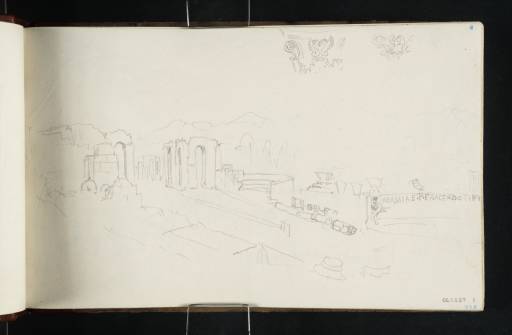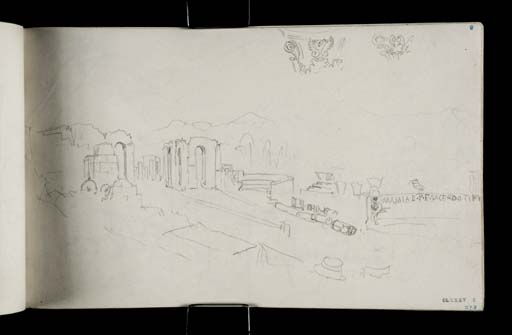Joseph Mallord William Turner View of the Porta Ercolano, Pompeii, with the Schola Tomb of Mamia on the Via dei Sepolcri 1819
Image 1 of 2
Joseph Mallord William Turner,
View of the Porta Ercolano, Pompeii, with the Schola Tomb of Mamia on the Via dei Sepolcri
1819
Joseph Mallord William Turner 1775–1851
Folio 8 Recto:
View of the Porta Ercolano, Pompeii, with the Schola Tomb of Mamia on the Via dei Sepolcri 1819
D15751
Turner Bequest CLXXXV 8
Turner Bequest CLXXXV 8
Pencil on white wove paper, 113 x 189 mm
Inscribed by the artist in pencil with Latin text, see main catalogue entry
Inscribed by ?John Ruskin in blue ink ‘278’ bottom right and ‘8 top right
Stamped in black ‘CLXXXV 8 bottom right
Inscribed by ?John Ruskin in blue ink ‘278’ bottom right and ‘8 top right
Stamped in black ‘CLXXXV 8 bottom right
Accepted by the nation as part of the Turner Bequest 1856
References
1909
A.J. Finberg, A Complete Inventory of the Drawings of the Turner Bequest, London 1909, vol.I, p.547, as ‘Do. [Ruins]’.
1984
Cecilia Powell, ‘Turner on Classic Ground: His Visits to Central and Southern Italy and Related Paintings and Drawings’, unpublished Ph.D thesis, Courtauld Institute of Art, University of London 1984, pp.186 note 74, 491 note 32.
1987
Cecilia Powell, Turner in the South: Rome, Naples, Florence, New Haven and London 1987, pp.79 note 25, [82] note 60.
Turner entered the ancient archeological site of Pompeii from the north-west, through the Porta Ercolano (Herculaneum Gate), a gate in the city walls which was approached from the Via dei Sepolcri (Street of the Tombs), and ultimately the main road from Herculaneum and Rome. This sketch depicts the remains of the western face of the gate which would originally have supported a monumental arch spanning the road. To the right is the top of the Via dei Sepolcri with two schola tombs, sepulchral monuments in the form of a semicircular bench, particularly common near the gates of a city.1 Turner has transcribed part of the Latin dedication from the exedra bench on the right. The full inscription to Mamia, the owner of the tomb, reads ‘MAMIAE. P. F. SACERDOTI. PVBLICAE. LOCVS. SEPVLTVR. DATVS. DECVRIONVM. DECRETO’ (To Mamia, daughter of Publius Mamius, City Priestess. Gravesite given by decree of the Town Council). The continuation of the sketch and the remainder of the inscription can be found on folio 9 (D15753). During the early nineteenth century the Via dei Sepolcri was one of the most impressive and fully excavated sections of the Pompeii site, and consequently it was a popular subject for topographical artists. This composition is virtually identical to that of the engraved plate after an 1817 drawing by James Pattinson Cockburn (1779–1847).2
In the top right-hand corner of the page are studies of decorative capitals from a tomb decorated with garland reliefs on the opposite site of the street, see folio 7 (D15750). Further sketches of the Via dei Sepolcri can be found on folios 5–7, 9 verso–10 (D15746–D15750, D15754–D15755). For a general discussion of Turner’s visit to Pompeii see the introduction to the sketchbook.
Nicola Moorby
September 2010
See definition in Lawrence Richardson, A New Topographical Dictionary of Ancient Rome, Baltimore 1992, p.345.
How to cite
Nicola Moorby, ‘View of the Porta Ercolano, Pompeii, with the Schola Tomb of Mamia on the Via dei Sepolcri 1819 by Joseph Mallord William Turner’, catalogue entry, September 2010, in David Blayney Brown (ed.), J.M.W. Turner: Sketchbooks, Drawings and Watercolours, Tate Research Publication, December 2012, https://www


